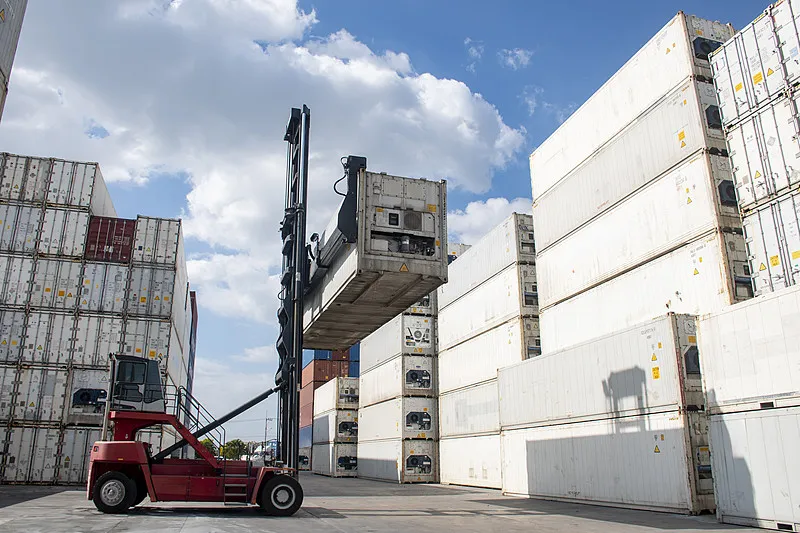China is a key trading partner for the United Kingdom, not only as one of its largest sources of imports but also as a growing destination for UK exports. For businesses engaged in China–UK trade, the timeliness of cross-border freight is critical. It directly affects supply chain stability, inventory management, and the ability to respond swiftly to market opportunities.
Understanding and optimizing the transit times associated with different shipping methods is essential for maintaining a competitive edge. In this article, we’ll explore the typical transit durations of the two primary transportation modes between China and the UK: sea freight and air freight. We’ll also provide actionable strategies to help businesses improve logistics efficiency and reduce lead times.

How Are Goods Shipped from China to UK?
There are two primary methods for shipping goods from China to UK, each with its advantages depending on your business needs:
- Sea Freight: This is the most common and cost-effective option, especially for large volumes, heavy cargo, or non-time-sensitive goods. Shipments are typically transported in containers—either as Full Container Loads (FCL) or less than Container Loads (LCL), depending on the size and volume of the cargo.
- Air Freight: This is the fastest shipping method and is ideal for small shipments, high-value items, urgent orders, or perishable goods. Although more expensive, air freight significantly reduces transit time and offers more predictable delivery.
Businesses usually rely on freight forwarders to manage the shipping process. Freight forwarders can consolidate shipments, offer a range of services—from port-to-port to door-to-door—and handle complex logistics such as customs clearance, space booking, and required documentation, making the process much smoother and more efficient.
Factors Affecting Transportation Time from China to the UK
Whether you’re shipping by sea or air, the total transit time from China to the UK is shaped by various factors. Understanding these variables is essential for effective logistics planning and avoiding unexpected delays. Key considerations include:
- Mode of Transportation: Sea freight is more economical but takes significantly longer than air freight, which offers much faster delivery at a higher cost.
- Origin and Destination Points: Transit times vary depending on the specific ports, cities, or airports involved and the distance between inland locations and major hubs.
- Service Type: Standard services generally have longer lead times than express or priority services, which offer faster transit for a premium.
- Route or Flight Path: Direct shipping and non-stop flights reduce travel time, while transshipment or layover routes can add days to the journey.
- Carrier Efficiency: The performance and reliability of the shipping line or airline, such as frequency of departures, transit schedules, and handling capabilities, can impact overall delivery times.
- Port or Airport Congestion: Busy seasons or special circumstances (e.g., large-scale events or surges in volume) may lead to delays due to bottlenecks at ports or airports.
- Customs Clearance Efficiency: Delays at the Chinese export or UK import customs checkpoints, especially when inspections are triggered, can extend transit times.
- Document Preparation: Timely and accurate preparation of customs documentation is critical. Errors or missing paperwork can cause processing delays and additional scrutiny.
- Weather Conditions: Severe weather, such as typhoons or snowstorms, can disrupt vessel schedules, flight departures, and arrivals.
- Peak Seasons & Holidays: National holidays, such as Chinese New Year or Golden Week in China and bank holidays in the UK, often result in reduced staffing and slower processing at ports and customs offices.
- Global or Regional Disruptions: Events like pandemics, geopolitical tensions, strikes, or other force majeure scenarios can significantly impact shipping routes and timelines.

Sea Freight Time from China to the UK
Sea freight is one of the most widely used methods for international shipping due to its cost-effectiveness and capacity for large volumes. Cargo departing from China typically follows a route through Southeast Asia, across the Indian Ocean, and via the Suez Canal before arriving at a UK port.
On average, the shipping time ranges from 30 to 40 days. However, this can vary depending on several factors, such as the origin and destination ports, carrier schedules, transshipment stops, customs clearance efficiency, and weather conditions.
| POL (port of loading) | POD (port of discharge) | Shipping time (days) |
|---|---|---|
| Shanghai | London | 30-38 days |
| Shenzhen | London | 32-40 days |
| Ningbo | London | 31-39 days |
| Shanghai | Southampton | 33-39 days |
| Shenzhen | Southampton | 31-40 days |
| Ningbo | Southampton | 30-38 days |
| Shanghai | Felixstowe | 30-39 days |
| Shenzhen | Felixstowe | 31-38 days |
| Ningbo | Felixstowe | 31-40 days |
| Shanghai | Liverpool | 33-40 days |
| Shenzhen | Liverpool | 30-39 days |
| Ningbo | Liverpool | 32-40 days |
Air Freight Time from China to the UK
Air freight is the fastest mode of cross-border transportation and is ideal for time-sensitive shipments. Most air cargo between China and the UK is transported via direct flights, significantly reducing transit time. However, in some cases, goods may require transshipment through intermediate hubs, where layovers and handling delays can extend the total delivery time.
Air freight from China to the UK takes approximately 4 to 7 days, depending on the departure and arrival airports, carrier schedules, customs processing, and whether the shipment is consolidated or handled individually.
| Departure Airport (China) | Arrival Airport (Ireland) | Shipping time (days) |
| Shanghai Pudong | London Heathrow | 4-7 days |
| Guangzhou Baiyun | London Heathrow | 5-7 days |
| Beijing Capital | London Heathrow | 4-6 days |
| Shanghai Pudong | Manchester | 5-6 days |
| Guangzhou Baiyun | Manchester | 4-7 days |
| Beijing Capital | Manchester | 4-6 days |
| Shanghai Pudong | Birmingham | 4-7 days |
| Guangzhou Baiyun | Birmingham | 5-7 days |
| Beijing Capital | Birmingham | 4-6 days |
If you’re looking for estimated shipping times from China to other regions, please refer to the information below:
How Long Does it Take to Ship from China to Iran
How Long Does it Take to Ship from China to Nigeria
How Long Does it Take to Ship from China to Austria?
How Long Does it Take to Ship from China to Tanzania?
How to Optimize Shipping Times from China to the UK
Efficient logistics management is key to maintaining a competitive edge in international trade. Here are practical strategies to reduce delays and ensure timely delivery when shipping goods from China to the UK:
- Plan Ahead: Finalize orders and shipping requirements early. Allow sufficient lead time for production, documentation, and booking to avoid costly last-minute arrangements.
- Choose the Right Mode of Transport: Select between sea freight (standard or express) and air freight (economy or priority) based on the urgency and value of the shipment. Opt for efficient port or airport pairings and use reputable carriers with strong track records.
- Partner with Hongocean Freight Forwarder: Experienced freight forwarders like Hongocean offer tailored logistics solutions, manage complex procedures and provide end-to-end coordination—from booking to final delivery.
- Ensure Accurate and Complete Documentation: Prepare all necessary documents in advance, including commercial invoices, packing lists, bills of lading, and certificates of origin. Any discrepancies can cause customs delays.
- Optimize Inland Transportation: Coordinate pick-ups and last-mile deliveries efficiently. Work with dependable domestic trucking companies to avoid unnecessary delays at either end of the supply chain.
- Use Real-Time Tracking Technology: Leverage tracking tools to monitor your shipment’s progress. Proactive updates help you quickly identify and address potential issues during transit.
- Prioritize Direct Routes: When possible, choose direct sailings or non-stop flights. While slightly more expensive, they significantly reduce transit times and minimize the risk of delays from transshipment.
- Negotiate and Clarify Incoterms: Use appropriate Incoterms to define clear responsibilities between buyers and sellers. Ensuring the responsible party controls each stage helps maintain tight schedules and reduce uncertainty.

What are the main shipping routes from China to the UK?
For sea transport, the primary routes from major Chinese ports (such as Shanghai, Ningbo, Shenzhen, Qingdao, Xiamen, and Tianjin) to major UK ports (such as Felixstowe, Southampton, London Gateway, and Liverpool) are:
- Suez Canal Route: The most commonly used and typically the fastest route. Ships depart from China, head west across the South China Sea, the Malacca Strait, and the Indian Ocean, enter the Red Sea, pass through the Suez Canal into the Mediterranean Sea, then traverse the Strait of Gibraltar into the Atlantic Ocean, and finally arrive at UK ports.
- Via the Cape of Good Hope route: This route bypasses the southern tip of Africa at the Cape of Good Hope, is longer in distance, and is typically only chosen when the Suez Canal is blocked or for specific cost/strategic considerations.


